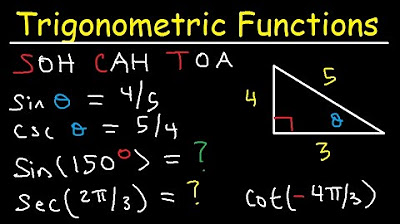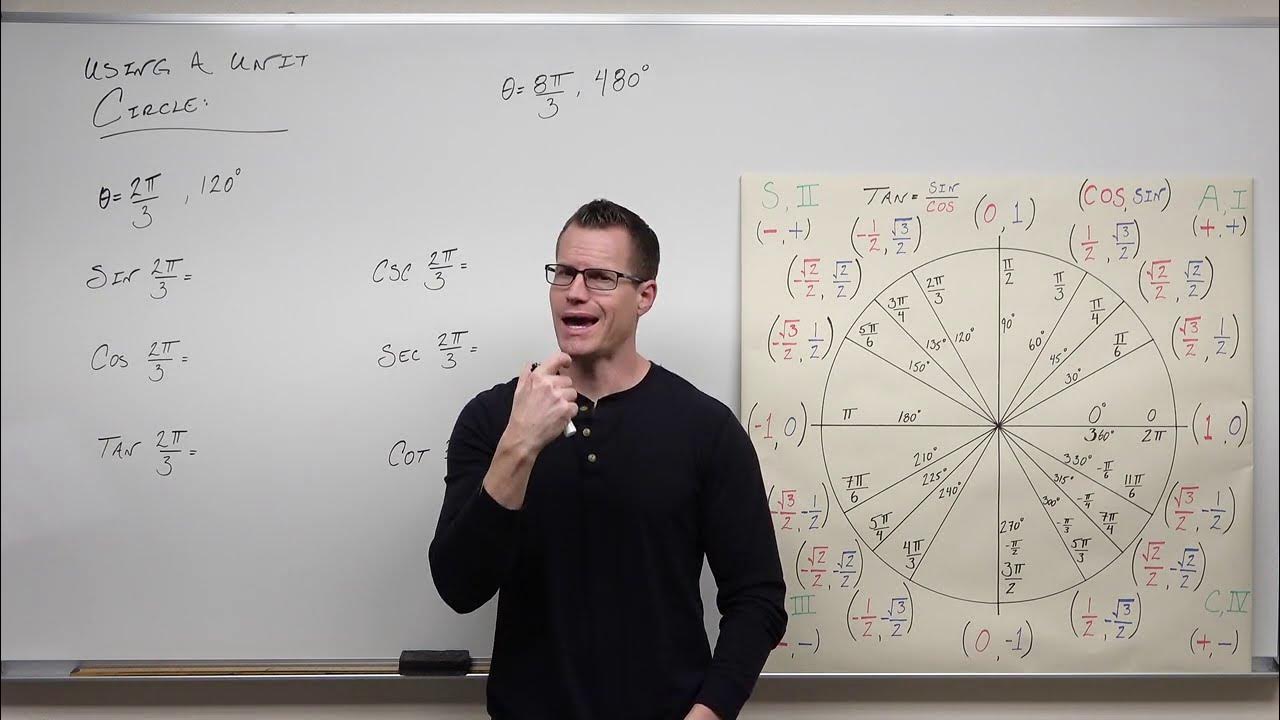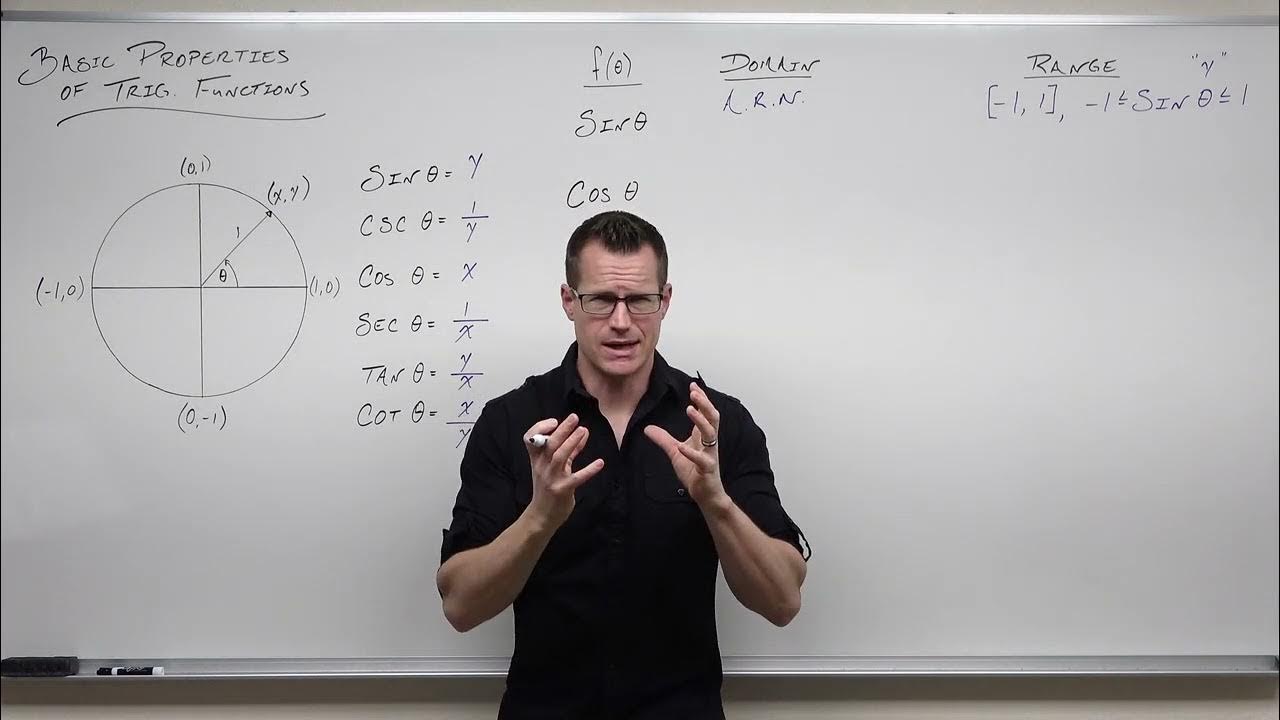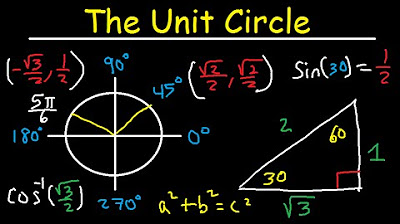An Indepth Look at Using Inverse Trig Functions (Precalculus - Trigonometry 21)
TLDRThe video script delves into the application of inverse trigonometric functions, such as arcsine, arccosine, arctangent, and their reciprocals like cosecant, secant, and cotangent. It emphasizes the importance of understanding the unit circle and the domains of these functions to accurately find angles based on given coordinates. The script provides a comprehensive guide on how to use inverse functions to map points on the unit circle to their corresponding angles, and vice versa, using the sine, cosine, and tangent functions. It also addresses the challenges of working with inverse functions outside the unit circle by constructing right triangles and applying the Pythagorean theorem. The video aims to clarify the process of finding angles for various trigonometric function values and the interplay between different trigonometric functions and their inverses, offering multiple examples to solidify the concepts.
Takeaways
- 📐 The unit circle is fundamental in understanding inverse trigonometric functions, as it helps to visualize the relationship between angles and their corresponding coordinates.
- ↔️ Inverse trigonometric functions reverse the process of regular trigonometric functions, taking a coordinate value and outputting the angle that creates that coordinate.
- 🚫 Domain restrictions are crucial for inverse trigonometric functions to work correctly, ensuring a one-to-one mapping between angles and coordinates.
- 🔄 Reciprocal relationships between sine and cosecant, and between cosine and secant, allow for the simplification of inverse functions by converting them into more familiar trigonometric functions.
- 🧭 The quadrant in which an angle lies is essential when working with inverse trigonometric functions, as it determines the sign of the coordinates and the appropriate function to use.
- ⌛ When an inverse trigonometric function does not directly yield an angle, drawing a right triangle and applying trigonometric relationships can help find the required angle.
- 🤔 Understanding the signs of coordinates in different quadrants is vital for determining the correct angle when working with inverse trigonometric functions.
- 🛠 The Pythagorean theorem is often used in conjunction with inverse trigonometric functions to find the missing sides of a right triangle when the angle is known.
- 📉 Asymptotes on the unit circle define the limits of the domains for the inverse trigonometric functions and must be considered when evaluating these functions.
- 🔢 Calculators can provide decimal approximations for angles when working with inverse trigonometric functions, but it's important to ensure the calculator is set to the correct mode (radians or degrees).
- 🤓 Mastery of inverse trigonometric functions comes from practice and understanding the underlying geometry and algebra, rather than relying solely on calculator tools.
Q & A
What is the main topic discussed in the video?
-The video discusses the use of inverse trigonometric functions, specifically sine, cosine, and tangent inverse, as well as the inverses of cosecant, secant, and cotangent.
What is the relationship between sine and its inverse function?
-The sine inverse function (also known as arcsine) takes a y-coordinate value from the unit circle and returns the angle (theta) that corresponds to that y-coordinate.
How does the domain of the sine function affect its inverse?
-The domain of the sine function is restricted to create a one-to-one function, which allows the inverse sine function to work effectively. This is done to avoid multiple angles having the same y-coordinate value.
What is the range of angles for which the sine inverse function is defined?
-The sine inverse function is defined for angles ranging from negative pi over two to pi over two (-π/2 to π/2).
How does the video demonstrate the process of finding the angle for sine inverse of a given value?
-The video uses the example of sine inverse of the square root of 2 over 2, showing that this value corresponds to the angle pi over four (π/4) on the unit circle.
What is the relationship between the tangent function and its inverse?
-The tangent inverse function (also known as arctangent) takes a y/x value and returns the angle that corresponds to that ratio, just as the tangent function takes an angle and returns the ratio of y to x.
Why is it necessary to consider the domain when working with inverse trigonometric functions?
-The domain is necessary to ensure that the inverse trigonometric function is one-to-one, meaning each output corresponds to a unique input, which is required for the inverse function to be valid.
How does the video approach the calculation of cosine of an angle found using an inverse trigonometric function?
-The video explains that once an angle is found using an inverse trigonometric function, the cosine of that angle can be calculated by recognizing that cosine takes an angle as input and provides an x-coordinate as output.
What is the significance of the unit circle in the context of inverse trigonometric functions?
-The unit circle is a visual tool used to find angles that correspond to given y or x coordinates when working with inverse trigonometric functions. It helps to visualize the relationship between angles and coordinates.
How does the video handle the calculation of the tangent of an angle found using the cosine inverse function?
-The video demonstrates that after finding the angle using the cosine inverse function, one can substitute this angle into the tangent function to find the corresponding y/x ratio, which is the tangent of the angle.
What is the process for finding the angle when dealing with the secant inverse function?
-The video explains that the secant inverse function will give an angle when provided with a y/x value. By finding the reciprocal of the y/x value and using the domain of the secant inverse function, one can find the corresponding angle.
Outlines
😀 Understanding Inverse Trigonometric Functions
This paragraph introduces the concept of inverse trigonometric functions, specifically arcsine, arccosine, and arctangent. It explains how these functions 'undo' the regular trigonometric functions to find the angle from a given coordinate on the unit circle. The importance of defining the domain for sine to create a one-to-one function is discussed, and the domains for sine, cosine, and tangent inverses are described.
🎓 Applying Inverse Functions to Find Angles
The paragraph demonstrates how to apply inverse trigonometric functions to find angles when given a coordinate. It uses the example of sine inverse of the square root of 2/2 to illustrate the process, emphasizing the need to consider the correct domain and how the unit circle can be used to find the angle that corresponds to a given y-coordinate.
🔢 Trigonometric Functions and Their Inverses
This section explores the relationship between regular trigonometric functions and their inverses. It explains how the outputs of inverse functions (angles) can be used as inputs for regular trigonometric functions. Examples include finding the cosine of an angle found using sine inverse and the tangent of an angle found using cosine inverse.
📐 Evaluating Inverse Trigonometric Functions with Coordinate Values
The paragraph focuses on evaluating inverse trigonometric functions when given specific coordinate values. It discusses the process of finding the angle that corresponds to a given x-coordinate for cosine inverse and a y-coordinate for sine inverse. The concept of using the unit circle to find these angles is emphasized.
🤔 Dealing with Inverse Trigonometric Functions Outside the Unit Circle
This part of the script addresses the challenge of dealing with inverse trigonometric functions when the context is outside the unit circle. It explains how to create a right triangle to find the necessary angle and then use that angle to evaluate the trigonometric function. The paragraph uses the example of sine of tangent inverse of one-half to illustrate this process.
🧮 Working with Inverse Trigonometric Functions and Their Reciprocals
The paragraph discusses the reciprocal relationships between certain trigonometric functions and their inverses, such as sine and cosecant, and how these relationships can be used to simplify the evaluation of inverse functions. It also explains the need to consider the domain of the functions when evaluating inverses and provides examples using cosecant and secant inverses.
📐 Using Pythagorean Theorem for Non-Unit Circle Inverse Functions
This section explains how to use the Pythagorean theorem to find the hypotenuse of a right triangle when dealing with inverse trigonometric functions that are not on the unit circle. It demonstrates how to find the angle that corresponds to a given y/x ratio by creating a triangle and using the Pythagorean theorem to find the missing side.
🔁 Finding Inverse Functions of Trigonometric Functions
The paragraph shows how to find the inverse functions of regular trigonometric functions. It emphasizes that these inverse functions will always be defined everywhere except where there is a vertical asymptote on the unit circle. The process involves finding the trigonometric function first and then restricting the domain to find the inverse.
🧲 Dealing with Cotangent Inverse Functions
This part of the script focuses on the special case of cotangent inverse functions, which do not match up well with the interval for tangent inverse functions. It explains how to deal with cotangent inverses by using the appropriate trigonometric function that overlaps in the same interval, such as cosine inverse, to find the angle.
🔍 Using Reciprocal Relationships for Inverse Trigonometric Functions
The final paragraph discusses the reciprocal relationships between cosecant and sine, and secant and cosine, which allows for a simplification when finding the inverse of these functions. It also provides an alternative method for finding the inverse of cosecant and secant functions using the sine and cosine inverses, respectively.
Mindmap
Keywords
💡Inverse Functions
💡Unit Circle
💡Trigonometric Ratios
💡Domain and Range
💡Reciprocal Trigonometric Functions
💡Pythagorean Theorem
💡Rationalization
💡Trigonometric Identities
💡Even and Odd Functions
💡Quadrants
💡Calculator Usage
Highlights
Introduction to inverse trigonometric functions: sine inverse, cosine inverse, tangent inverse, and their applications.
Explanation of how inverse functions reverse the process of normal trigonometric functions to find angles from coordinates.
The importance of domain and range in ensuring a one-to-one function for inverse trigonometric functions to work correctly.
Use of the unit circle to find angles for sine, cosine, and tangent inverse functions within specific quadrants.
Procedure to find the angle for sine inverse of a given y-coordinate, such as sine inverse of square root of 2 over 2.
Understanding that the outputs of inverse trigonometric functions are angles, which can then be used as inputs for regular trigonometric functions.
Method to find cosine of an angle derived from cosine inverse, such as cosine of pi over 4.
Approach to deal with tangent inverse when the function is not defined on a unit circle by creating a right triangle.
Technique to find the angle for cotangent inverse that does not correspond to a unit circle using a triangle and cosine inverse.
Explanation of how to handle secant inverse and cosecant inverse by utilizing their corresponding trigonometric functions due to matching domains.
Process to find the angle for trigonometric functions when the radius of the circle is not one, using the Pythagorean theorem.
Use of reciprocal relationships between sine and cosecant, and cosine and secant, to simplify the process of finding inverse functions.
Handling of cotangent inverse by recognizing its different domain and using the appropriate trigonometric function based on the quadrant.
Strategy to find angles for inverse trigonometric functions when they do not correspond to a unit circle using calculator functions.
Emphasis on the importance of understanding the unit circle and the domains of trigonometric functions for solving inverse functions.
Illustration of how to find the angle for sine inverse and use it to calculate the sine of that angle, even without knowing the angle's exact value.
Comprehensive examples demonstrating the process of finding angles from inverse trigonometric functions and then evaluating the original trigonometric functions.
Transcripts
Browse More Related Video

Trigonometric Functions of Any Angle - Unit Circle, Radians, Degrees, Coterminal & Reference Angles

How to Use the Unit Circle in Trigonometry (Precalculus - Trigonometry 7)

Basic Properties of Trigonometric Functions (Precalculus - Trigonometry 8)

Trigonometry: Unit Circle

Unit Circle Trigonometry - Sin Cos Tan - Radians & Degrees

Trig Visualized: One Diagram to Rule them All (six trig functions in one diagram)
5.0 / 5 (0 votes)
Thanks for rating: